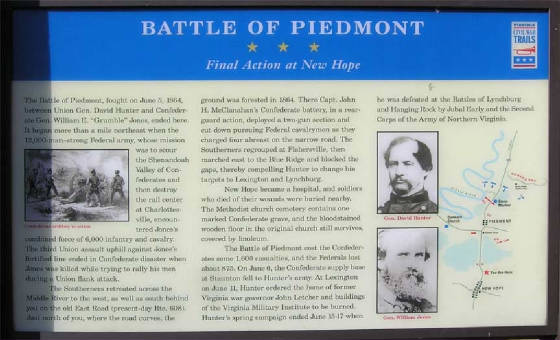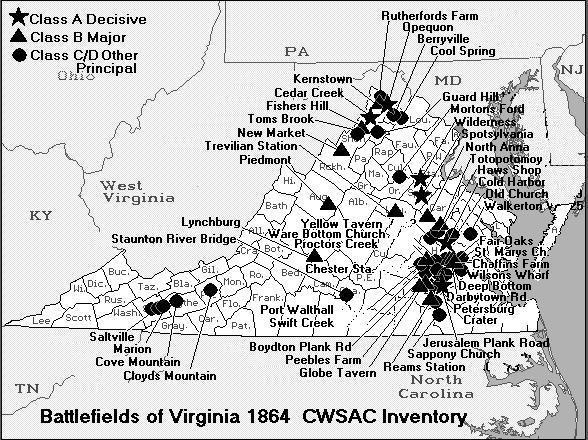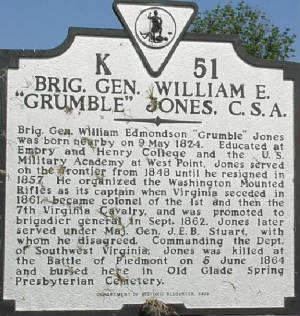|
Civil War Battle of Piedmont, Virginia, History
Campaign: Hunter’s Lynchburg Campaign; 1864 Shenandoah Valley Campaigns
Principal Commanders: [C] Brig. Gen. William E. “Grumble”
Jones; [U] Maj. Gen. David Hunter
Forces Engaged: [C] Two infantry brigades (Jones and Browne),
home guards, and cavalry under Imboden and Vaughn, about 5,500; [U] Sullivan's division (two brigades under Moor and Thoburn),
Stahel's cavalry division, and artillery under DuPont, about 8,500
Estimated Casualties: [C]
1,500 (100k/500w/900m&c); [U] 875 (150k/650w/75m)
| Battle of Piedmont Virginia |

|
| (Click to Enlarge) |
Setting the Stage: The Battle of Piedmont was one of many battles fought during
the Lynchburg Campaign. The Lynchburg Campaign, also known as Hunter's Lynchburg Campaign, was part of the Shenandoah
Valley Campaigns of 1864 and was the first of three principal campaigns fought throughout the valley region.
Lynchburg Campaign [May-June 1864] consisted of the following battles:
New Market – Piedmont – Lynchburg.
Significance: On 5 June 1864, the US
army of General David Hunter crushed the smaller Confederate army at Piedmont, killing the
CS commander (General "Grumble'' Jones) and taking nearly 1,000 prisoners. Piedmont was an
unmitigated disaster for CS arms in the Valley. The disorganized Confederates could do nothing to delay Hunter's advance to
Staunton, where he was reinforced by Brig. Gen. George Crook's
Army of West Virginia marching from the west. United, the US forces moved
on Lynchburg. Hearing of Jones' defeat, Gen. Robert E. Lee
first rushed J. C. Breckinridge's division back to Rockfish Gap (7 June) and then detached the Second Corps of the Army of
Northern Virginia under Lt. Gen. Jubal “Ole Jube” Early to confront Hunter at Lynchburg (12 June). This detachment
severely limited Lee's ability to undertake defensive-offensive operations on the Richmond-Petersburg lines, during the Siege of Petersburg, and served to open up the Shenandoah Valley as a second front in the 1864 fighting in Virginia.
Description of the Battle
Cavalry Action at Mt. Meridian: Shortly after dawn, 5 June 1864, US cavalry advanced on the Staunton Road and met CS cavalry under Brig. Gen. John D. Imboden at Mt. Meridian. The US
troopers were driven back until reinforced and again advanced to Mt.
Meridian, supporting their attack with ten field pieces. The Confederates
responded with two guns. Imboden continued to delay the US
advance, while gradually retiring. US
cavalry incurred about 100 casualties in the morning's action. Fighting occurred around Bonny Doon. In the wake of the cavalry,
US infantry marched south from Port Republic.
| Battle of Piedmont, Virginia, Civil War Map |

|
| (Virginia Civil War Battlefield Map) |
CS Deployment at Piedmont: General ``Grumble'' Jones deployed
his army in an ``L'' anchored on a bend of Middle River facing north and bending south along the ridge line. He placed his two veteran
brigades (under Col. Beuhring Jones and Col. William H. Browne) on the left and center behind barricades of fence rails. His
reserves, which consisted of home guards, were drawn up in the woods just south and west of Piedmont.
Vaughn's cavalry brigade was in position along the Cross Road
(present day rte. 778) east of Piedmont. His line was supported by artillery. Jones made
his headquarters in a tent in the yard of the modern McDonald House. (Imboden's cavalry brigade after the morning's delaying
action withdrew behind Polecat Draft near Round Hill.)
US Advance to Piedmont: About 1000 hours, US cavalry drove the CS troopers back to the main infantry line at Piedmont
and then withdrew out of cannon range to await the arrival of their infantry and artillery. Moor's brigade arrived first and
deployed to the right of the road into the river bend. They were fired on by CS skirmishers. Thoburn's brigade deployed to
the left of the road in the vicinity of the Shaver House. DuPont arrayed his artillery battalion on the heights confronting
the CS position. Hunter made his headquarters in the Shaver House. One brigade of US cavalry was held in reserve.
US
Attacks on the Right: DuPont massed 22 guns against the angle in the CS line, eventually forcing two batteries to retire
and take up a position closer to Piedmont village. Shortly after noon, elements of Moor's brigade (18CT) assaulted the hill
to their right front, driving out the CS skirmishers. Supported by a regiment of Thoburn's brigade, Moor's entire line advanced,
driving back the advanced CS line on the northern brow of the ridge. Jones withdrew his infantry to barricades along Walker's Lane, reinforced his left to meet the US
charges, and launched a counterattack. Fighting swayed back and forth across the fields. Hunter now reinforced Moor with Wynkoop's
cavalry brigade, fighting dismounted, and renewed his attack.
US Attack on the Left: While fighting raged on the right, Col.
Thoburn led three regiments through a ravine and woods on the left and attacked across the Givens Run Valley.
Mid-afternoon, he charged directly into a gap in the CS line that was opened when Jones reinforced his left flank. CS reserves
were advancing to fill the gap but Thoburn's regiment reached the crest first, and a savage, hand-to-hand mel‚e erupted.
About this time, Gen. Jones was killed, and the CS defense came unraveled. Inexplicably, the CS cavalry (Vaughn) witnessed
Thoburn's attack but did not advance.
CS Rout: Pressed on the front and rear, Confederate soldiers
went streaming over the steep bluffs behind to wade and swim the river. All order was lost. A nasty skirmish was fought over
possession of the ford to the rear of the Col. Crawford House. Stahel's US
cavalry division advanced on the far left to close in on the village by the Cross
Road. They were met by Vaughn's and Imboden's cavalry who at last came into play to act as rear
guard. Some CS units attempted to stand near the Middle River Church
and at New Hope, and US
pursuit gradually slackened. The CS army lost about 900 captured. (Advance to Battle of Piedmont.)
| Battle of Piedmont Civil War History |

|
| General "Grumble" Jones |
Aftermath: The Battle of Piedmont was fought June
5, 1864, in the village of Piedmont, Augusta County, Virginia. Union Maj. Gen. David Hunter engaged Confederates under Brig.
Gen. William E. "Grumble" Jones north of Piedmont. After severe fighting, Jones was killed and the Confederates were routed.
Hunter occupied Staunton on June 6 and soon began to advance on Lynchburg, destroying military stores and public property
in his wake. Hunter, however, was foiled in his plan to destroy railroads, canals, and hospitals in Lynchburg when initial
units under Jubal A. Early arrived. Hunter, short on supplies, retreated back through West Virginia. (See Civil War Battle of Piedmont, Virginia: A History.)
Source: National Park Service: American Civil War
Recommended
Reading: Shenandoah Summer: The 1864 Valley Campaign. Description: Jubal A. Early’s disastrous battles in the Shenandoah Valley
ultimately resulted in his ignominious dismissal. But Early’s lesser-known summer campaign of 1864, between his raid
on Washington and Phil Sheridan’s renowned fall campaign, had a significant impact on the political and military landscape
of the time. By focusing on military tactics and battle history in uncovering the facts and events of these little-understood
battles, Scott C. Patchan offers a new perspective on Early’s contributions to the Confederate war effort—and
to Union battle plans and politicking. Patchan details the previously unexplored battles at Rutherford’s Farm and Kernstown
(a pinnacle of Confederate operations in the Shenandoah Valley) and examines the campaign’s
influence on President Lincoln’s reelection efforts. Continued below…
He also provides
insights into the personalities, careers, and roles in Shenandoah of Confederate General John C. Breckinridge, Union general
George Crook, and Union colonel James A. Mulligan, with his “fighting Irish” brigade from Chicago.
Finally, Patchan reconsiders the ever-colorful and controversial Early himself, whose importance in the Confederate military
pantheon this book at last makes clear. About the Author: Scott C. Patchan, a Civil War battlefield guide and historian, is
the author of Forgotten Fury: The Battle of Piedmont, Virginia, and a consultant and contributing writer for Shenandoah, 1862.
Review
"The author's
descriptions of the battles are very detailed, full or regimental level actions, and individual incidents. He bases the accounts
on commendable research in manuscript collections, newspapers, published memoirs and regimental histories, and secondary works.
The words of the participants, quoted often by the author, give the narrative an immediacy. . . . A very creditable account
of a neglected period."-Jeffry D. Wert, Civil War News (Jeffry D. Wert Civil War News 20070914)
"[Shenandoah
Summer] contains excellent diagrams and maps of every battle and is recommended reading for those who have a passion for books
on the Civil War."-Waterline (Waterline 20070831)
"The narrative
is interesting and readable, with chapters of a digestible length covering many of the battles of the campaign."-Curled Up
With a Good Book (Curled Up With a Good Book 20060815)
"Shenandoah
Summer provides readers with detailed combat action, colorful character portrayals, and sound strategic analysis. Patchan''s
book succeeds in reminding readers that there is still plenty to write about when it comes to the American Civil War."-John
Deppen, Blue & Grey Magazine (John Deppen Blue & Grey Magazine 20060508)
"Scott C. Patchan
has solidified his position as the leading authority of the 1864 Shenandoah Valley Campaign with his outstanding campaign
study, Shenandoah Summer. Mr. Patchan not only unearths this vital portion of the campaign, he has brought it back to life
with a crisp and suspenseful narrative. His impeccable scholarship, confident analyses, spellbinding battle scenes, and wonderful
character portraits will captivate even the most demanding readers. Shenandoah Summer is a must read for the Civil War aficionado
as well as for students and scholars of American military history."-Gary Ecelbarger, author of "We Are in for It!": The First
Battle of Kernstown, March 23, 1862 (Gary Ecelbarger 20060903)
"Scott Patchan
has given us a definitive account of the 1864 Valley Campaign. In clear prose and vivid detail, he weaves a spellbinding narrative
that bristles with detail but never loses sight of the big picture. This is a campaign narrative of the first order."-Gordon
C. Rhea, author of The Battle of the Wilderness: May 5-6, 1864 (Gordon C. Rhea )
"[Scott Patchan]
is a `boots-on-the-ground' historian, who works not just in archives but also in the sun and the rain and tall grass. Patchan's
mastery of the topography and the battlefields of the Valley is what sets him apart and, together with his deep research,
gives his analysis of the campaign an unimpeachable authority."-William J. Miller, author of Mapping for Stonewall and Great
Maps of the Civil War (William J. Miller)
Recommended
Reading: The
Shenandoah Valley Campaign of 1864 (McFarland & Company). Description: A
significant part of the Civil War was fought in the Shenandoah Valley of Virginia, especially in 1864. Books and articles
have been written about the fighting that took place there, but they generally cover only a small period of time and focus
on a particular battle or campaign. Continued below...
This work covers
the entire year of 1864 so that readers can clearly see how one event led to another in the Shenandoah Valley and turned once-peaceful
garden spots into gory battlefields. It tells the stories of the great leaders, ordinary men, innocent civilians, and armies
large and small taking part in battles at New Market, Chambersburg, Winchester, Fisher’s
Hill and Cedar Creek, but it primarily tells the stories of the soldiers, Union and Confederate,
who were willing to risk their lives for their beliefs. The author has made extensive use of memoirs, letters and reports
written by the soldiers of both sides who fought in the Shenandoah Valley in 1864.
Recommended
Reading: The
Shenandoah Valley Campaign of 1864 (Military Campaigns of the Civil War) (416 pages) (The University of North
Carolina Press). Description: The 1864 Shenandoah Valley Campaign
is generally regarded as one of the most important Civil War campaigns; it lasted more than four arduous months and claimed
more than 25,000 casualties. The massive armies of Generals Philip H. Sheridan and Jubal A. Early had contended for immense
stakes... Beyond the agricultural bounty and the boost in morale to be gained with its numerous battles, events in the Valley
would affect Abraham Lincoln's chances for reelection in November 1864. Continued below...
The eleven
essays in this volume reexamine common assumptions about the campaign, its major figures, and its significance. Taking advantage
of the most recent scholarship and a wide range of primary sources, contributors examine strategy and tactics, the performances
of key commanders on each side, the campaign's political repercussions, and the experiences of civilians caught in the path
of the armies. The authors do not always agree with one another, but, taken together, their essays highlight important connections
between the home front and the battlefield, as well as ways in which military affairs, civilian experiences, and politics
played off one another during the campaign.
Recommended
Reading: From Winchester to Cedar Creek: The Shenandoah Campaign
of 1864. Amazon.com Review: Virginia's Shenandoah Valley was a crucial avenue for Confederate armies
intending to invade Northern states during the Civil War. Running southwest to northeast, it "pointed, like a giant's lance,
at the Union's heart, Washington, D.C.,"
writes Jeffry Wert. It was also "the granary of the Confederacy," supplying the food for much of Virginia. Both sides long understood its strategic importance, but not until the fall of
1864 did Union troops led by Napoleon-sized cavalry General Phil Sheridan (5'3", 120 lbs.) finally seize it for good. He defeated
Confederate General Jubal Early at four key battles that autumn. Continued below…
In addition
to a narrative of the campaign (featuring dozens of characters, including General George Custer and future president Rutherford
B. Hayes), this book is a study of command. Both Sheridan and Early were capable military leaders, though
each had flaws. Sheridan tended to make mistakes before battles,
Early during them. Wert considers Early the better general, but admits that few could match the real-time decision-making
and leadership skills of Sheridan once the bullets started
flying: "When Little Phil rode onto the battlefield, he entered his element." Early was a bold fighter, but lacked the skills
necessary to make up for his disadvantage in manpower. At Cedar Creek, the climactic battle of the 1864 Shenandoah campaign,
Early "executed a masterful offensive against a numerically superior opponent, only to watch it result in ruin." With more
Confederate troops on the scene, history might have been different. Wert relates the facts of what actually happened with
his customary clarity and insightful analysis.
Recommended
Reading: The Official Virginia Civil War Battlefield Guide. Review: This is one of the most useful guides I've ever read.
Virginia was host to nearly one-third of all Civil War engagements,
and this guide covers them all like a mini-history of the war. Unlike travel books that are organized geographically, this
guide organizes them chronologically. Each campaign is prefaced by a detailed overview, followed by concise (from 1 to 4 pages,
depending on the battle's importance) but engrossing descriptions of the individual engagements. Continued below…
These descriptions
make this a great book to browse through when you're not in the car. Most sites' summaries touch on their condition--whether
they're threatened by development (as too many are) and whether they're in private hands or protected by the park service.
But the maps are where this book really stands out. Each battle features a very clear map designating army positions and historical
roads, as well as historical markers (the author also wrote “A Guidebook to Virginia's Historical Markers”), parking, and visitors'
centers. Best of all, though, many battles are illustrated with paintings or photographs of the sites, and the point-of-view
of these pictures is marked on each map!
Recommended Reading: General Lee's Army: From Victory to Collapse
(Hardcover). Review: You cannot say that University of North Carolina professor Glatthaar
(Partners in Command) did not do his homework in this massive examination of the Civil War–era lives of the men in Robert
E. Lee's Army of Northern Virginia. Glatthaar spent nearly 20 years examining and ordering primary source material to ferret
out why Lee's men fought, how they lived during the war, how they came close to winning, and why they lost. Glatthaar marshals
convincing evidence to challenge the often-expressed notion that the war in the South was a rich man's war and a poor man's
fight and that support for slavery was concentrated among the Southern upper class. Continued below...
Lee's army
included the rich, poor and middle-class, according to the author, who contends that there was broad support for the war in
all economic strata of Confederate society. He also challenges the myth that because Union forces outnumbered and materially
outmatched the Confederates, the rebel cause was lost, and articulates Lee and his army's acumen and achievements in the face
of this overwhelming opposition. This well-written work provides much food for thought for all Civil War buffs.
|

